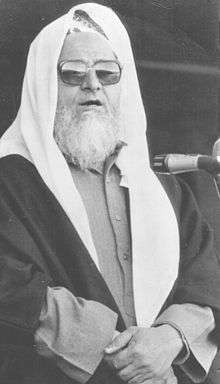Muhammad Abdullah Ghazi
Maulana Muhammad Abdullah Ghazi (Urdu:محمد عبد اللہ غازی)Son of (Ghazi Muhammad), was born on 1 June 1935 and died 17 October 1998. He was born in the far-flung village of Rajanpur, Basti-Abdullah, into the family of farmer. His father was socially active which got him in trouble many times and he was arrested by the British and sentenced to 8 years in jail. In jail he became religious and motivated Abdullah to enrolled into a local madrassa at the age of 7 and later he moved to Karachi for further study. In accordance with his father's wish, he dedicated himself to study and graduated from Jamia Uloom-ul-Islamia in Banori-town Karachi. He was appointed as the first Imam of the Lal Masjid in 1966. He created many seminaries in Pakistan and the first time in Pakistan, he introduced a female madrassa education system and created Pakistan's first female seminary Jamia Hafsa. In 1997 he was appointed as Chairman of Ruet-e-Hilal committee till his assassination 1998. He had good relations with other sects and non-Muslims. His biographer, Riaz Mansoor, states.
Muhammad Abdullah Ghazi محمد عبد اللہ غازی | |
|---|---|
 | |
| Born | 1 June 1935 Basti-Abdullah, British India |
| Died | 17 October 1998 (aged 63) |
| Cause of death | Assassination (multiple gunshots) |
| Resting place | Islamabad, pakistan |
| Nationality | Pakistan |
| Children | Abdul Aziz Ghazi Abdul Rashid Ghazi |
| Signature | |
 | |
Soviet war in Afghanistan
During the Soviet war in Afghanistan (1979–1989), the Red Mosque played a major role in recruiting and training Mujahideen to fight alongside the Afghan Mujahideen against Soviet troops. A few months before his assassination in 1998 Moulana Abdullah together with Moulana Zahoor Ahmad Alwi, Qari Saeed-ur-Rehman and some other scholars toured Afghanistan. Maulana took his rebellious son (Abdul Rashid Ghazi) specially with him. This delegation met Mullah Omar, Osama Bin Laden. and Dr Ayman Al Zawahiri
Assassination
His biographer, Riaz Mansoor, states That Maulana had a routine every day whereby he would walk to a seminary for giving lectures (7 km away from the Red-Mosque). On the day of his assassination he walked to his Madrassa Jamia Ul Ulom al Islamia al Faridia Also Known As The Al Faridia University and returned by car at noon. As he got out of the car, his elder son Maulana Maulana Abdul Aziz Ghazi approached him and spoke to him. When Moulana approached his house, a man standing in front of the door walked towards him and pulled out a gun and opened fire until the magazine was empty, badly injuring Moulana. Afterwards, he fired at Abdul-aziz, who barely escaped death. The assassin escaped with the help of an accomplice waiting outside in a car. Moulana Abdullah died of his injuries on the way to the hospital.
FIR and Case
Due to lack of trust in Pakistan's legal system, his elder son refused to lodged FIR, but his younger son, Abdul Rashid Ghazi lodged the FIR and the police investigated the case. After a relentless effort, a man was arrested and afterwards, during the ID parade, an eye witness identified the assassin. However, he was released the next day without reason. Abdul Rashid Ghazi protested against the release and warned the police of legal action if the suspect was not arrested soon. With Ghazi increasing pressure on police, he was asked to withdraw the case or face the fate of his father. According to his friend, this was turning point in Ghazi's life, and he became disillusioned him with system.
Biography
In 2005, A Biography Was Released Detailing Maulana's Life Under The Name Hayat Shaheed E Islam By Riaz Munsoor